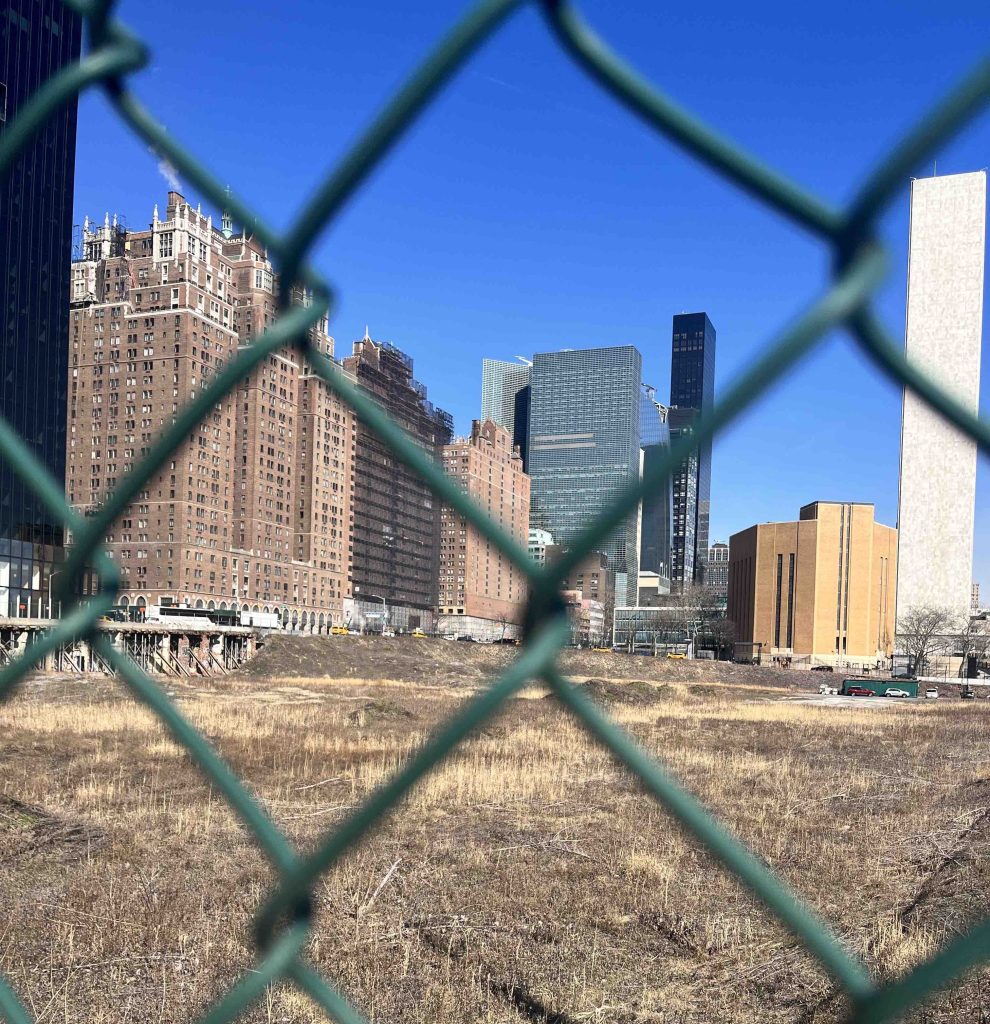This article is part of the Under the Lens series

666 First Ave., New York, N.Y. Photo by Josie Faass
New York City has long been known for its high cost of living, but the problem has taken on a new urgency of late. Manhattan’s median rents are above $4,000 per month, according to the U.S. Bureau of Labor Statistics, and the median house price citywide is now north of $750,000 according to Zillow—both high-water marks for the city’s real estate market. Accordingly, policy makers and advocates are focused on easing the financial burden of housing, and many have turned their attention to the dual issues of faceless corporate landlords and the stubborn presence of vacant and underutilized lots across all five boroughs.
At Resource Justice, we have investigated the relationship between speculative vacancy and limited liability company (LLC) landlords in NYC. We combined publicly available data and advanced mapping and statistical analyses to confirm what had previously been hidden in plain sight: Corporate investors are using the legal advantages of the LLC structure to engage in land speculation throughout New York City, purchasing properties in prime locations and holding them in an underdeveloped condition as residents struggling against an unforgiving real estate market beg for new housing stock.
Financialization of Housing and LLCs
No discussion of the modern real estate market is complete without an examination of the role of corporate investors. This “financialization of housing” describes the increasing use of complicated financial and legal structures to repackage housing into a speculative investment asset, and is blamed for pushing homeownership even further out of reach for the middle class. A 2015 New York Times investigation revealed that LLCs are a popular corporate structure for wealthy individuals, including many overseas officials, to purchase property in New York City while avoiding taxes.
LLCs first appeared in the late 1970s, and were originally created to protect Wyoming’s oil and gas investors from personal liability. Despite this legal advantage, however, LLCs saw minimal use for real estate investment until 1988, when the IRS determined they should be taxed as partnerships, rather than corporations. Soon after, LLC statutes were enacted in all 50 states and their numbers exploded across the U.S., increasing some 750 percent between 1990 and 2012.
The appeal of LLCs derives from the fact that they combine the benefits of a traditional corporate structure with enhanced anonymity and reduced tax liabilities: a win-win-win for investors. Unfortunately, those same characteristics tend to encourage bad behavior when this particular legal structure is used for the purpose of real estate investing. For example, it is well documented that LLC owners are more likely than other property owners to reduce costs by minimizing spending on the maintenance of their properties. As a result, their properties experience more rapid deterioration than non-LLC owned parcels, a finding that demonstrates the strategy of short-term rent extraction rather than long-term housing provision enabled by this particular legal structure.
The anonymity afforded LLC owners also makes it very difficult for tenants and neighbors to hold owners accountable for delayed maintenance, poor site conditions, and the negative spillover effects of long term vacancy. And because liability is inherently limited, even when an owner is identified, there may be very minimal assets available to make the parties harmed by the LLC whole.
Finally, the LLC structure enables investors to purchase small slivers of large, diversified real estate portfolios through fractional ownership arrangements. With control of only a small percentage of a property, investors reap the benefits of ownership without the burdens of the traditional landlord’s role.
Given all of these benefits, it’s hardly surprising that the LLC structure is a favorite among real estate investors. In 2019, 15 percent of all rental properties in the United States were owned by an LLC and that number has steadily increased as the financialization of housing continues unabated. Nationwide, more LLCs are formed each year than corporations and fully one fifth of business profits are paid out to LLCs, the majority of which comes from real estate.
Despite the popularity of LLCs, however, not just anyone is likely to become an LLC owner. Overwhelmingly, those who do are in the top 1 percent of the income and wealth distributions, and the vast majority are white and male. To cite a familiar example, the fact that Donald Trump had holdings in at least 96 LLCs contributed significantly to his ability to withhold personal financial information during the 2016 election. LLCs have therefore become a key mechanism for widening the chasm of wealth inequality.
How We Connected Vacancy and LLCs
Resource Justice started with the City of New York’s MapPLUTO database, which contains information on all taxable lots across the five boroughs. We removed publicly owned parcels, parks, cemeteries, and other lots that cannot reasonably be expected to sustain additional development, reducing the dataset to just over 840,000 properties.
We considered parcels LLC-owned if the “owner” field in the tax records contained a combination of the terms “LLC,” “LTD,” “limited liability,” or “limited corp.” LLCs often register parcels using the street name in lieu of the owner’s name, so parcels with an exact match between the address field and owner name field were also included. Using this approach, we identified close to 111,000 LLC-owned parcels in NYC, representing about 13 percent of the dataset.
We considered a parcel vacant if it had a positive assessed land value, was not fully tax exempt, and the MapPLUTO land use was coded as “Vacant Land” or the assessed value of the buildings on the parcel was $0. Using these criteria, vacant parcels were found to constitute 2.2 percent of the dataset.
The term “underutilized” is harder to define than “vacant.” Following others’ examples, we included any lot where the built floor space is less than half of the maximum allowable. By this metric, more than 25 percent of all residential and commercial lots can be classified as underutilized citywide.
How Connected Are They?
Even before performing the first statistical analysis, a cursory glance at the cleaned data made clear that LLCs own a disproportionate amount of New York City’s vacant and underutilized land: of the roughly 18,000 vacant parcels, 5,200 are LLC-owned. More in-depth analyses confirmed that LLCs are significantly more likely to own vacant and underutilized properties across New York City, even when controlling for potentially confounding factors. Specifically, we find that vacant properties have a 9 to 15 percentage point higher likelihood of being owned by an LLC.
These buyers also clearly prefer particular types of parcels over others. The larger the lot, the more likely it is to be LLC-owned, and the same is true of properties with high value zoning (retail, commercial, high density residential) and those that have been recently rezoned. Parcels that are closer to water, have enhanced accessibility (due to positioning on a corner and/or are close to subway stops), and are more proximate to the city center (we used the Empire State building as the “center”) are also more likely to have an LLC owner.
LLC ownership is more common in Manhattan and in areas with higher population density. Areas that are whiter, have higher employment, and have higher labor force participation rates see more LLC purchases, a finding consistent with the notion of investing with the expectation of the kind of speculative uplift possible in desirable locales.
These results show that LLC speculators are actively driving the land underutilization and vacancy that are worsening New York City’s housing affordability crisis. In order to get a sense of what this trend looks like on the ground, however, let’s consider two (in)famous examples of LLC land speculation in New York.
514 11th Ave.
This 2-acre plot—formerly a bustling Mercedes dealership—was acquired by investor Larry Silverstein using an LLC in 2015. Upon purchasing the site for $100 million, Silverstein immediately demolished the structures on it, leaving behind a large vacant lot in the heart of the city that is currently zoned for commercial or residential development. Several proposals have come and gone for the site, but nothing has been done with it. Even in this disinvested state, the property’s value continues to rise and is estimated to be more than 150 percent what it was when acquired less than a decade ago.
Given its prime location and favorable zoning, why has the owner resisted reusing the site? A large part of the explanation probably lies in its tax valuation. At just $21 million, the cost of holding the land idle while the actions of the real estate market boost its value is enticingly low when compared with the benefits of speculation.
666 First Ave.
The 6-acre parcel at 666 First Ave. is evidence of how persistent LLC-driven land speculation can be, even in the face of public scrutiny. Ownership of the property was deftly hidden behind multiple layers of LLCs, but its large size and high value garnered attention, and reporters eventually tied its ownership to the well-known (now deceased) real estate investor Sheldon H. Solow.
This large lot once housed the Consolidated Edison powerhouse, but since that facility was demolished in 2006, the entire block has remained stubbornly vacant. It is currently zoned residential and lies in an inclusionary housing special area, making it a prime candidate for redevelopment into affordable housing. The parcel’s complete disuse hasn’t stymied its appreciation, however. The city valuation of 666 First Ave. has skyrocketed from $29 million in 2013 to around $146 million in 2022—another example of an LLC investor using land speculation to turn a profit in New York City.
What Can Be Done?
There have already been calls to strip LLCs of the privileges that make them so attractive to bad actors. At the most basic level, policymakers should require LLC landlords to divulge the identities of their beneficial owners. This would go a long way toward increasing accountability to their tenants and enabling communities to pressure negligent landlords to reuse their land (or sell to someone who will). And, as is currently being considered in many taxing jurisdictions—including Detroit, Minnesota; Buffalo, and the state of California—policymakers should encourage redevelopment by shifting the burden of their property taxes onto land and away from improvements. New York City would do well to explore such a policy intervention.
The need for affordable housing has only grown more urgent. Addressing the legal structures that facilitate wasteful land speculation and creating a tax environment that encourages the supply of housing are important steps toward ensuring New Yorkers’ access to this basic human right.






Comments